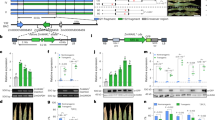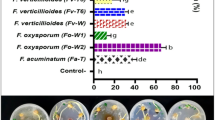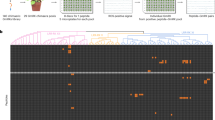Abstract
Pathogens deploy effectors to suppress host immune responses and enable successful colonization in plants. While apoplastic effectors have major roles in pathogenicity, whether and how they directly attack extracellular immune receptors remains unclear. Here we identify an apoplastic effector FgLPMO9A from the fungal pathogen Fusarium graminearum that directly inhibits maize immune receptor ZmLecRK1-mediated resistance. FgLPMO9A belongs to the polysaccharide monooxygenase family, which depolymerizes polysaccharides. Deletion of FgLPMO9A attenuates F. graminearum virulence on maize, but this defect is fully rescued in the zmlecrk1 mutants. FgLPMO9A interacts with the extracellular S-domain of ZmLecRK1 and disrupts N-glycosylation at the N341 site, thereby promoting ZmLecRK1 degradation via the NBR1-mediated autophagy pathway. Notably, the ZmLecRK1 variant with the N341Q substitution confers enhanced resistance to F. graminearum in maize. We demonstrate that F. graminearum dampens maize immunity by deploying an apoplastic effector to induce extracellular immune receptor degradation.
This is a preview of subscription content, access via your institution
Access options
Access Nature and 54 other Nature Portfolio journals
Get Nature+, our best-value online-access subscription
$32.99 / 30 days
cancel any time
Subscribe to this journal
Receive 12 digital issues and online access to articles
$119.00 per year
only $9.92 per issue
Buy this article
- Purchase on SpringerLink
- Instant access to full article PDF
Prices may be subject to local taxes which are calculated during checkout




Similar content being viewed by others
Data availability
The data that support the findings of this study are available in the source data. The CDS sequence of ZmLecRK1 (GRMZM2G330751) was retrieved from the MaizeGDB database (https://www.maizegdb.org/). All mass spectrometry raw data are available via the public database ProteomeXchange at https://www.ebi.ac.uk/pride/. The N-glycosylation identification of ZmLecRK1ECD+TM is available as project accession PXD066789. The determination of N-glycosylation level of ZmLecRK1ECD+TM after co-incubation with FgLPMO9A or FgLPMO9AH107A is available as project accession PXD066790. Source data are provided with this paper.
References
Doehlemann, G. & Hemetsberger, C. Apoplastic immunity and its suppression by filamentous plant pathogens. N. Phytol. 198, 1001–1016 (2013).
Wang, Y. & Wang, Y. Trick or treat: microbial pathogens evolved apoplastic effectors modulating plant susceptibility to infection. Mol. Plant Microbe Interact. 31, 6–12 (2018).
Wang, Y., Pruitt, R. N., Nürnberger, T. & Wang, Y. Evasion of plant immunity by microbial pathogens. Nat. Rev. Microbiol. 20, 449–464 (2022).
Jones, J. D. G. & Dangl, J. L. The plant immune system. Nature 444, 323–329 (2006).
Zipfel, C. Plant pattern-recognition receptors. Trends Immunol. 35, 345–351 (2014).
Couto, D. & Zipfel, C. Regulation of pattern recognition receptor signalling in plants. Nat. Rev. Immunol. 16, 537–552 (2016).
Zhou, J.-M. & Zhang, Y. Plant immunity: danger perception and signaling. Cell 181, 978–989 (2020).
Evangelisti, E. & Govers, F. Roadmap to success: how Ooomycete plant pathogens invade tissues and deliver effectors. Annu. Rev. Microbiol. 78, 493–512 (2024).
Macho, A. P. & Zipfel, C. Targeting of plant pattern recognition receptor-triggered immunity by bacterial type-III secretion system effectors. Curr. Opin. Microbiol. 23, 14–22 (2015).
Rocafort, M., Fudal, I. & Mesarich, C. H. Apoplastic effector proteins of plant-associated fungi and oomycetes. Curr. Opin. Plant Biol. 56, 9–19 (2020).
Buscaill, P. & van der Hoorn, R. A. L. Defeated by the nines: nine extracellular strategies to avoid microbe-associated molecular patterns recognition in plants. Plant Cell 33, 2116–2130 (2021).
Dora, S., Terrett, O. M. & Sánchez-Rodríguez, C. Plant–microbe interactions in the apoplast: communication at the plant cell wall. Plant Cell 34, 1532–1550 (2022).
Li, Z. et al. Natural variations of maize ZmLecRK1 determine its interaction with ZmBAK1 and resistance patterns to multiple pathogens. Mol. Plant 17, 1606–1623 (2024).
Hao, Z. et al. Genome sequence analysis of the fungal pathogen Fusarium graminearum using Oxford Nanopore Technology. J. Fungi 7, 699 (2021).
Nekiunaite, L. et al. FgLPMO9A from Fusarium graminearum cleaves xyloglucan independently of the backbone substitution pattern. FEBS Lett. 590, 3346–3356 (2016).
Agger, J. W. et al. Discovery of LPMO activity on hemicelluloses shows the importance of oxidative processes in plant cell wall degradation. Proc. Natl Acad. Sci. USA 111, 6287–6292 (2014).
Kim, S., Ståhlberg, J., Sandgren, M., Paton, R. S. & Beckham, G. T. Quantum mechanical calculations suggest that lytic polysaccharide monooxygenases use a copper-oxyl, oxygen-rebound mechanism. Proc. Natl Acad. Sci. USA 111, 149–154 (2014).
Luo, X. et al. A lectin receptor-like kinase mediates pattern-triggered salicylic acid signaling. Plant Physiol. 174, 2501–2514 (2017).
Harris, L. J., Balcerzak, M., Johnston, A., Schneiderman, D. & Ouellet, T. Host-preferential Fusarium graminearum gene expression during infection of wheat, barley, and maize. Fungal Biol. 120, 111–123 (2016).
Guo, L. et al. Compartmentalized gene regulatory network of the pathogenic fungus Fusarium graminearum. N. Phytol. 211, 527–541 (2016).
Naeem, M. et al. Transcriptional responses of Fusarium graminearum interacted with soybean to cause root rot. J. Fungi 7, 422 (2021).
Abramson, J. et al. Accurate structure prediction of biomolecular interactions with AlphaFold 3. Nature 630, 493–500 (2024).
Buscaill, P. et al. Subtilase SBT5.2 inactivates flagellin immunogenicity in the plant apoplast. Nat. Commun. 15, 10431 (2024).
Tong, X. et al. A small peptide inhibits siRNA amplification in plants by mediating autophagic degradation of SGS3/RDR6 bodies. EMBO J. 40, e108050 (2021).
Rasmussen, N. L., Kournoutis, A., Lamark, T. & Johansen, T. NBR1: the archetypal selective autophagy receptor. J. Cell Biol. 221, e202208092 (2022).
Zhou, T., Zhang, M., Gong, P., Li, F. & Zhou, X. Selective autophagic receptor NbNBR1 prevents NbRFP1-mediated UPS-dependent degradation of βC1 to promote geminivirus infection. PLoS Pathog. 17, e1009956 (2021).
Xu, C. & Ng, D. T. W. Glycosylation-directed quality control of protein folding. Nat. Rev. Mol. Cell Biol. 16, 742–752 (2015).
Lee, J. M., Hammarén, H. M., Savitski, M. M. & Baek, S. H. Control of protein stability by post-translational modifications. Nat. Commun. 14, 201 (2023).
Guan, F. et al. A lectin-based isolation/enrichment strategy for improved coverage of N-glycan analysis. Carbohydr. Res. 416, 7–13 (2015).
Goto, Y. et al. N-glycosylation is required for secretion and enzymatic activity of human hyaluronidase1. FEBS Open Bio. 4, 554–559 (2014).
Liu, C. et al. A dual‐subcellular localized β‐glucosidase confers pathogen and insect resistance without a yield penalty in maize. Plant Biotechnol. J. 22, 1017–1032 (2024).
Waterhouse, A. M., Procter, J. B., Martin, D. M., Clamp, M. & Barton, G. J. Jalview Version 2—a multiple sequence alignment editor and analysis workbench. Bioinformatics 25, 1189–1191 (2009).
Tamura, K., Stecher, G. & Kumar, S. MEGA11: molecular evolutionary genetics analysis version 11. Mol. Biol. Evol. 38, 3022–3027 (2021).
Teufel, F. et al. SignalP 6.0 predicts all five types of signal peptides using protein language models. Nat. Biotechnol. 40, 1023–1025 (2022).
Yin, W., Wang, Y., Chen, T., Lin, Y. & Luo, C. Functional evaluation of the signal peptides of secreted proteins. Bio Protoc. 8, e2839 (2018).
Jiang, C. et al. An expanded subfamily of G-protein-coupled receptor genes in Fusarium graminearum required for wheat infection. Nat. Microbiol. 4, 1582–1591 (2019).
Li, L., Wright, S. J., Krystofova, S., Park, G. & Borkovich, K. A. Heterotrimeric G protein signaling in filamentous fungi. Annu. Rev. Microbiol. 61, 423–452 (2007).
Catlett, N. L., Lee, B.-N., Yoder, O. C. & Turgeon, B. G. Split-marker recombination for efficient targeted deletion of fungal genes. Fungal Genet. Rep. 50, 9–11 (2003).
Jiang, C. et al. An orphan protein of Fusarium graminearum modulates host immunity by mediating proteasomal degradation of TaSnRK1α. Nat. Commun. 11, 4382 (2020).
Feng, C. et al. Uncovering cis-regulatory elements important for A-to-I RNA editing in Fusarium graminearum. MBio 13, e0187222 (2022).
Liu, H. et al. Two Cdc2 kinase genes with distinct functions in vegetative and infectious hyphae in Fusarium graminearum. PLoS Pathog. 11, e1004913 (2015).
Zhang, X. W. et al. In planta stage-specific fungal gene profiling elucidates the molecular strategies of Fusarium graminearum growing inside wheat coleoptiles. Plant Cell 24, 5159–5176 (2012).
Sabatke, B. et al. Host–pathogen cellular communication: the role of dynamin, clathrin, and macropinocytosis in the uptake of Giardia-derived extracellular vesicles. ACS Infect. Dis. 11, 954–962 (2025).
Rappsilber, J., Mann, M. & Ishihama, Y. Protocol for micro-purification, enrichment, pre-fractionation and storage of peptides for proteomics using StageTips. Nat. Protoc. 2, 1896–1906 (2007).
Zeng, W. et al. Precise, fast and comprehensive analysis of intact glycopeptides and modified glycans with pGlyco3. Nat. Methods 18, 1515–1523 (2021).
Xu, H. et al. An Agrobacterium-mediated transient expression method for functional assay of genes promoting disease in monocots. Int. J. Mol. Sci. 24, 7636 (2023).
Acknowledgements
We thank G. Bi, X. Tong, X. Wang and J. Fan for the helpful discussion and suggestions. We thank X. Liu for the F. graminearum FG-12 isolate, H. Liu for the HyTK fragment template and the fungal gene complementation system, F. Li for nbr1 Nicotiana mutants, G. Wang for the Rp1-D21 plasmid, J. Liu for the AtLecRK-IX.2 plasmid and J. Yang for the time course cDNA from F. graminearum PH-1-infected wheat spikes. We thank V. Bhadauria for the language improvement of the manuscript. This work was supported by the National Natural Science Foundation of China (grant nos. 32472499 to W.Z. and 32302371 to J.C.), Chinese Universities Scientific Fund (grant no. 2025TC026 to W.Z.), the National Key Research and Development Program, Ministry of Science and Technology of China (grant no. 2022YFD1201802 to W.Z.) and the Postdoctoral Fellowship Program of CPSF (grant no. GZC20252506 to C.L.).
Author information
Authors and Affiliations
Contributions
Conceptualization by C.L., J.C., Z.L. and W.Z. Methodology—formal analysis by C.L., J.C., Z.L. and W.Z. and investigation by C.L., J.C., Z.L., Z.Z., Y.L., Hui Liu, Hongtian Liu, J.H. and W.Z. Writing—original draft by C.L. and review and editing by J.C. and W.Z. Supervision by W.Z. Project administration by W.Z. Funding acquisition by W.Z.
Corresponding author
Ethics declarations
Competing interests
W.Z., C.L., Z.L. and J.C. (all from China Agricultural University) are co-inventors of a Chinese patent (no. 202510519347.5) based on the results described in this study. The other authors declare no competing interests.
Peer review
Peer review information
Nature Plants thanks Matthieu Joosten and the other, anonymous, reviewer(s) for their contribution to the peer review of this work.
Additional information
Publisher’s note Springer Nature remains neutral with regard to jurisdictional claims in published maps and institutional affiliations.
Extended data
Extended Data Fig. 1 The FgLPMO9A encodes an apoplastic effector protein.
a, FgLPMO9A and FgLPMO9AH107A do not induce cell death in N. benthamiana. b, Alignment of the homologous amino acid sequence of FgLPMO9A in the Fusarium genus. Sequence similarity is represented in blue, and red asterisks indicate copper ion binding sites. c, AlphaFold3-predicted protein structure of FgLPMO9A, highlighting the copper ion binding sites. d, Signal peptide prediction of FgLPMO9A using SignalP 6.0. e, Functional validation of the FgLPMO9A signal peptide in the yeast Saccharomyces cerevisiae YTK12 strain. Yeast carrying the FgLPMO9A signal peptide fused to the pSUC2 vector was able to grow on CMD-W and YPRAA media. pSUC2-Avr1bSP served as the positive control, while pSUC2-Mg87SP served as the negative control. Secreted invertase catalyzes the reduction of 2,3,5-triphenyltetrazolium chloride (TTC) to form insoluble red 1,3,5-triphenyl formazan (TPF). f, Subcellular localization of FgLPMO9A and FgLPMO9AΔSP in N. benthamiana before and after plasmolysis. FgLPMO9A-mCherry and FgLPMO9AΔSP-mCherry were transiently expressed, with GFP and mCherry empty vectors used as controls. After plasmolysis, the white dashed lines indicate the cell wall structure. Bar = 20 μm. These experiments were repeated 3 times with similar results.
Extended Data Fig. 2 Morphology phenotype of the FgLPMO9A knockout and complementation strains.
a, Schematic representation of the knockout and complementation strategy for the FgLPMO9A in F. graminearum. b, Molecular identification of knockout and complementation strains using four pairs of primers. c, Growth of mutant strains on PDA plates (Top: front view, middle: back view) and conidial morphology (Bottom). Bar = 100 μm. d, Statistical analysis of the colony diameter of mutant strains. The values are means ± SEM. (n = 6 biologically independent samples). e, Statistical analysis of the conidia counts of mutant strains. The values are means ± SEM. (n = 3 biologically independent samples). d and e, letters indicate statistically significant differences between groups, as determined by one-way ANOVA followed by Tukey’s test at α = 0.05. Three independent experiments were repeated with similar results.
Extended Data Fig. 3 FgLPMO9A interacts with the extracellular S-domain of ZmLecRK1.
a, Schematic diagram of the truncations in different domains of ZmLecRK1. b, FgLPMO9A primarily interacts with the extracellular S-locus domain of ZmLecRK1, as shown by the co-IP assay in N. benthamiana. c, The mutation of Y294A and 7 A of the extracellular domain of ZmLecRK1 weakens the interaction between ZmLecRK1 and FgLPMO9A, whereas the other six mutations did not affect the interaction, as shown by the co-IP assay in N. benthamiana. d, The mutation of ECD+TM7A weakens the interaction between ZmLecRK1 and FgLPMO9A, as shown by the co-IP assay in N. benthamiana. e, Y294 is the key site of ZmLecRK1 for the interaction between ZmLecRK1 and FgLPMO9A, as shown by the co-IP assay in N. benthamiana. f, FgLPMO9A does not suppress the cell death triggered by ZmLecRK17A and ZmLecRK1Y294A in N. benthamiana. All experiments were repeated 3 times with similar results.
Extended Data Fig. 4 FgLPMO9A induces the degradation of ZmLecRK1 through the autophagy pathway.
a, Western blot analysis shows that the protease inhibitor Epi1 does not affect FgLPMO9A-mediated degradation of the ZmLecRK1 in N, benthamiana. b, The protease inhibitor Epi1 does not affect the ability of FgLPMO9A to suppress ZmLecRK1-mediated cell death in N. benthamiana. c, FgLPMO9A induces degradation of the full-length (FL) ZmLecRK1 as well as the ECD+TM, but not the intracellular kinase domain (KD) of ZmLecRK1, as shown by the Western-blot in N. benthamiana leaves. d, MG132 and CPZ treatment do not inhibit FgLPMO9A-mediated degradation of the ZmLecRK1, as shown by the western blot in N. benthamiana. e, Effect of different inhibitors treatment on the suppression of ZmLecRK1-mediated cell death in N. benthamiana by FgLPMO9A. All experiment were repeated 3 times with similar results.
Extended Data Fig. 5 FgLPMO9A targets the N341 residue of ZmLecRK1 to inhibit ZmLecRK1-mediated cell death in N. benthamiana leaves.
a, Tu treatment suppresses ZmLecRK1-triggered cell death in N. benthamiana. b, Glycosylation mass spectrometry identifies ten N-glycosylation modification sites in the extracellular domain of ZmLecRK1. c, Effect of FgLPMO9A on different ZmLecRK1 N-glycosylation variants-mediated cell death in N. benthamiana. d, Western blot analysis of the protein levels of mutated ZmLecRK1s in N. benthamiana. e, Effect of FgLPMO9A on the protein accumulation of different ZmLecRK1 mutants, as shown by the western blot in N. benthamiana. These experiments were repeated 3 times with similar results.
Extended Data Fig. 6 FgLPMO9A targets the N341 residue of ZmLecRK1 to inhibit ZmLecRK1-mediated cell death in N. benthamiana leaves.
a, N341Q does not affect the interaction between ZmLecRK1ECD+TM and FgLPMO9A, as shown by the co-IP assay in N. benthamiana. b, FgLPMO9A treatment does not change the N-glycosylation level of ZmLecRK1ECD+TM with N341Q mutation, as shown by the Concanavalin A assay in N. benthamiana. c, Representative full scan MS spectra of the glycans released from ZmLecRK1ECD+TM following in vitro treatment with FgLPMO9A, exemplified by the glycan structure H(3)N(4)F(1)X(1). d, FgLPMO9A does not induce degradation of the ZmLecRK1N341Q variant, as shown by the western blot in N. benthamiana. e, FgLPMO9A cannot suppress ZmLecRK1N341Q-triggered cell death in N. benthamiana. f, Quantification of canonical N-glycosylation modification at N215 of ZmLecRK1ECD+TM with FgLPMO9A and FgLPMO9AH107A, as shown by spectrometry assay. These experiments were repeated 3 times with similar results.
Extended Data Fig. 7 Development of the transient gene expression system in maize leaves.
a, Schematic representation of maize at the V2 stage (left); fluorescence signals of the reporter gene LUC in different maize leaves after transient expression (middle); and statistical analysis of fluorescence intensity (right). L1, L2, and L3 represent the first, second, and third leaves in maize at the V2 stage, respectively. Data are shown mean ± SEM. (n = 3 biologically independent samples). Letters indicate significantly different groups, as determined by one-way ANOVA followed by Tukey’s test at α = 0.05. b, The transcriptional abundance of maize transient expression vectors in L1 leaves was analyzed using two pairs of primers via agarose gel electrophoresis. A schematic diagram of the primer design is shown (top), and PCR products were analyzed on a 2% agarose gel (bottom). ZmActin was used as an internal reference. PCR was performed for 30 cycles with primers 1 + 2, 32 cycles with primers 3 + 4, and 30 cycles with ZmActin. c, Confocal microscopy analysis of fluorescence signals in maize leaves transiently expressing GFP, ZmLecRK1-GFP, and ZmLecRK1N341Q-GFP vectors. Bar = 40 μm. These experiments were repeated 3 times with similar results.
Supplementary information
Supplementary Table 1
Protein sequences used for constructing the phylogenetic tree in this study.
Supplementary Table 2
Primers and markers used in this study.
Source data
Source data Fig. 1
Unprocessed western blots for Fig. 1.
Source data Fig. 2
Unprocessed western blots for Fig. 2.
Source data Fig. 3
Unprocessed western blots for Fig. 3.
Source data Fig. 4
Unprocessed western blots for Fig. 4.
Source data Table 1
Statistical source data for Figs. 1, 2, and 4.
Source data Extended Data Fig. 1/Table 1
Statistical source data for Extended Data Figs. 2, 6 and 7.
Source data Extended Data Fig. 2
Unprocessed gels for Extended Data Fig. 2.
Source data Extended Data Fig. 3
Unprocessed western blots for Extended Data Fig. 3.
Source data Extended Data Fig. 4
Unprocessed western blots for Extended Data Fig. 4.
Source data Extended Data Fig. 5
Unprocessed western blots for Extended Data Fig. 5.
Source data Extended Data Fig. 6
Unprocessed western blots for Extended Data Fig. 6.
Source data Extended Data Fig. 7
Unprocessed gels for Extended Data Fig. 7.
Rights and permissions
Springer Nature or its licensor (e.g. a society or other partner) holds exclusive rights to this article under a publishing agreement with the author(s) or other rightsholder(s); author self-archiving of the accepted manuscript version of this article is solely governed by the terms of such publishing agreement and applicable law.
About this article
Cite this article
Liu, C., Chen, J., Li, Z. et al. An apoplastic fungal effector disrupts N-glycosylation of ZmLecRK1, inducing its degradation to suppress disease resistance in maize. Nat. Plants (2025). https://doi.org/10.1038/s41477-025-02112-8
Received:
Accepted:
Published:
DOI: https://doi.org/10.1038/s41477-025-02112-8



